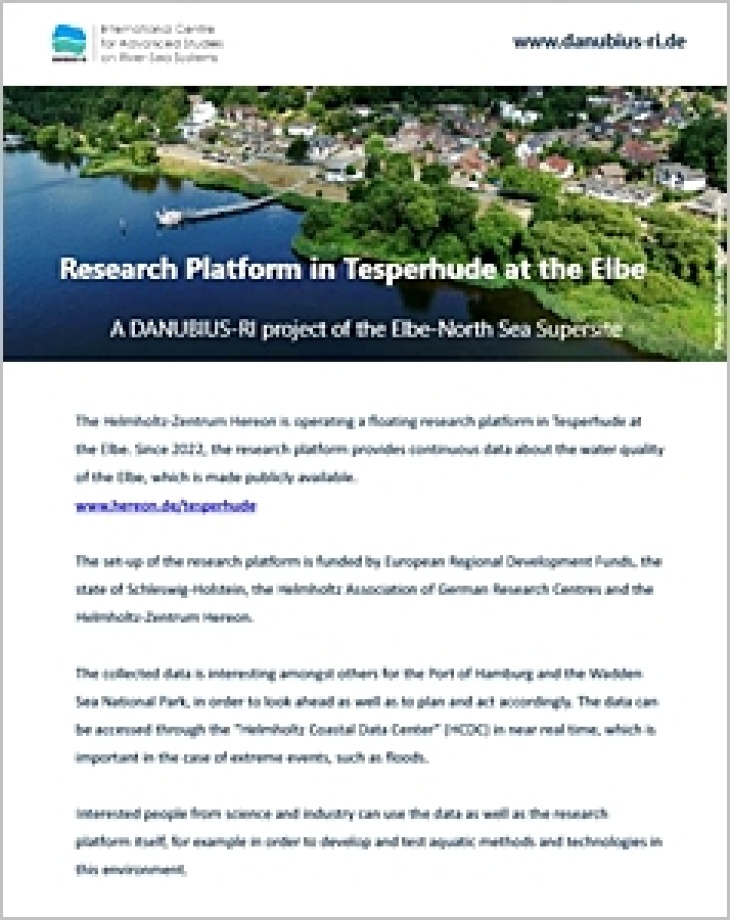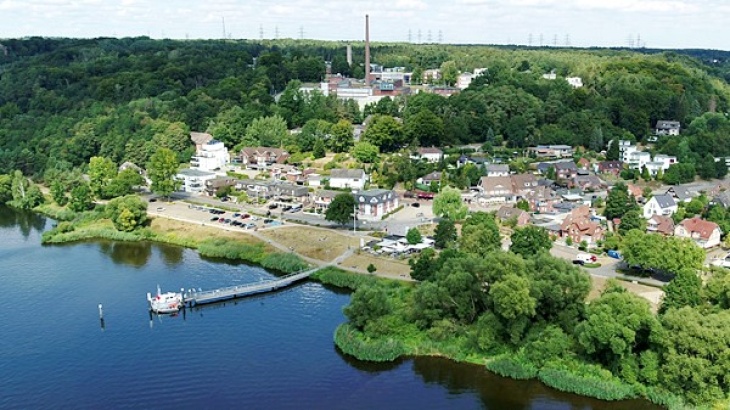
Aerial view on Tesperhude at river Elbe (Photo: Michael Streßer / Hereon)
The Helmholtz-Zentrum Hereon is operating a research platform in Tesperhude at the river Elbe. Starting in autumn 2022, the research platform provides continuous data about the water quality of the Elbe, which is made publicly available. Furthermore, the research platform can be used by interested people from science and industry. The set-up of the research platform has been funded by the European Regional Development Funds, the state of Schleswig-Holstein, the Helmholtz Association of German Research Centres and the Helmholtz-Zentrum Hereon.
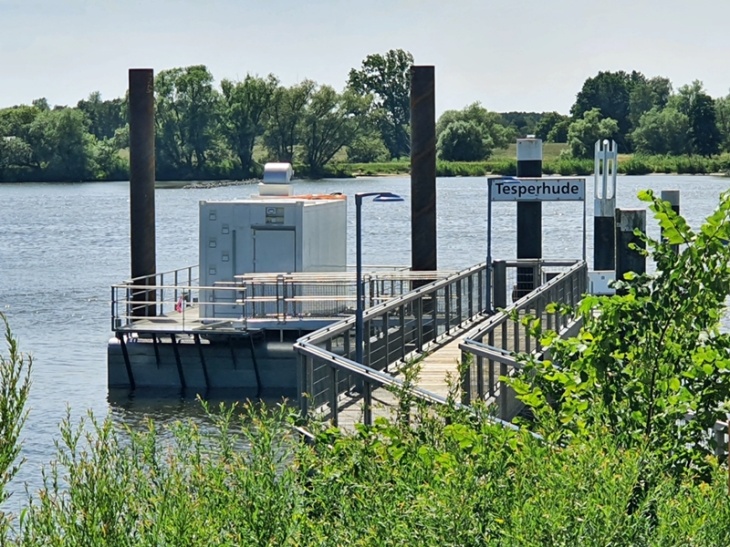
Research platform at the promenade pier (Photo: Jörn Pietsch / Hereon)
The research platform houses various scientific measurement systems. These provide continuous, high-resolution and real-time data on various substances in the water (for example, nutrients, suspended matter, microalgae, greenhouse gases and selected pollutants). The substances monitored here enter the Tidal Elbe estuary via the Geesthacht weir and influence substance turnover in the Port of Hamburg and further downstream into the adjacent North Sea.
The collected data is interesting for regional institutions like the Port of Hamburg and the Wadden Sea National Park, both as a source of upstream inputs into the Elbe estuary, but also to provide information on the regional variability (on a seasonal and interannual scale). For example the data, which can be accessed through the “Helmholtz Coastal Data Center“ (HCDC) in near real time, and which is important for example in the case of extreme events, such as floods. Interested users from science and industry can use the collected data, as well as the research platform itself, for example in order to develop and test aquatic methods and technologies in this environment.
Example: Measurement System „FerryBox“
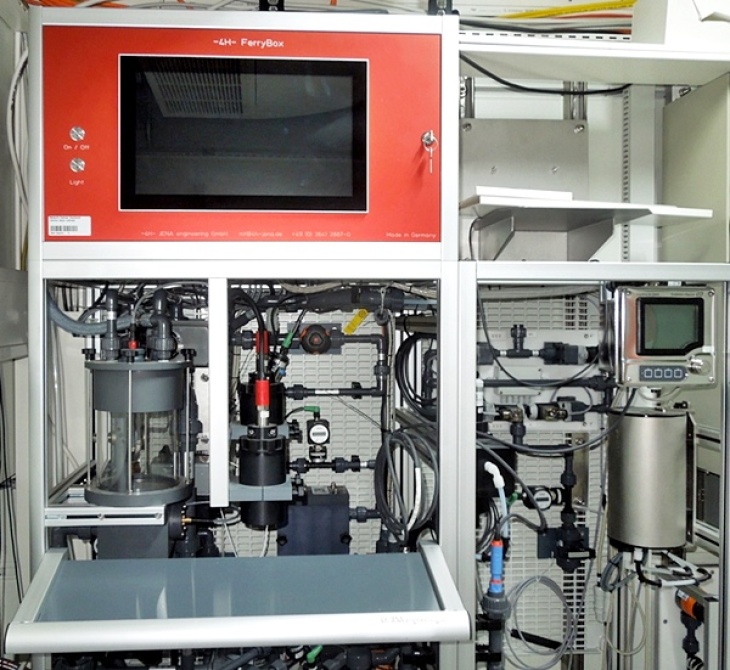
FerryBox installed in the container (Photo: Volker Dzaak / Hereon)
The FerryBox is an essential part of the research platform und has been developed together with Helmholtz-Zentrum Hereon. The automated measurement system determines physical and biogeochemical parameters in surface waters. The water is continuously pumped through a measurement cycle with several sensors.
The measurement system usually contains sensors for temperature, salinity, turbidity and chlorophyll flurorescence, as an indicator for microalgae. Additionally, sensors for oxygen, nutrients, pH, carbon dioxide and algae classes can be included.
The FerryBox is measuring numerous parameters every 20 seconds, but data is reported as an average of several minutes. The Helmholtz-Zentrum Hereon is operating several FerryBoxes, like Cuxhaven Station, located at the mouth of the Elbe in Cuxhaven, Germany.
Motivation
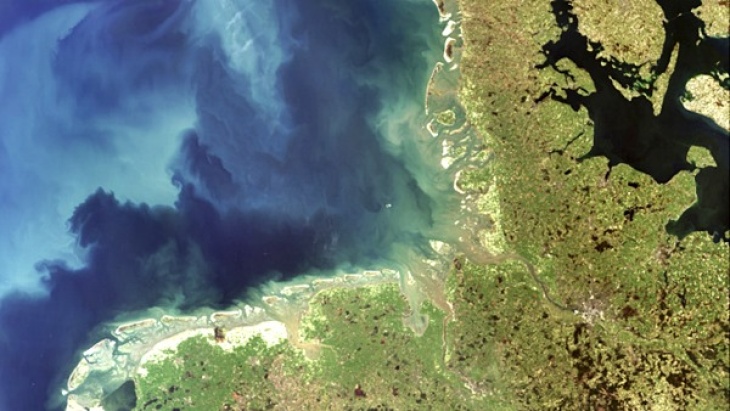
Satellite image North Germany with tidal Elbe and North Sea (Image: data by ESA, processed by Hereon)
The Elbe estuary from Geesthacht to the North Sea is an important waterway near the Port of Hamburg, serving as lifeline for the metropolitan region of Hamburg including its inhabitants and industries. However, this River-Sea System is changing continuously due to different human activities, as well as climate change.
At the research platform in Tesperhude, we can study changes in the amount and composition of suspended solids, nutrient concentrations and oxygen saturation. For example, degradation of high loads of organic matter can lead to oxygen deficiency. In order to anticipate these and other changes, and to be able to react quickly, scientists want to better understand the functioning of River-Sea Systems. The research platform in Tesperhude complements the existing measuring stations at the Elbe and its estuary.
The research platform is operated together with the research initiative MOSES (Modular Observation Solutions for Earth Systems) by the Helmholtz Association of German Research Centres. MOSES is investigating the interactions of short-term events, such as floods and heat waves, with long-term trends. Therefore, the partners are developing mobile and flexible measurement systems.
Furthermore, the research platform is incorporated into the Elbe-North Sea Supersite of the pan-European research infrastructure DANUBIUS-RI (International Centre for Advanced Studies on River-Sea Systems), which integrates studies in rivers and adjacent coastal seas. Currently, similar facilities are set-up in more than 10 locations across Europe in order to facilitate research along the river-sea continuum.
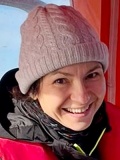
Helmholtz-Zentrum Hereon, Institute of Carbon Cycles
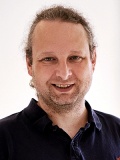
Head of Inorganic Environmental Chemistry
Phone: +49 4152 87 - 2846
E-mail contactHelmholtz-Zentrum Hereon, Institute of Coastal Environmental Chemistry
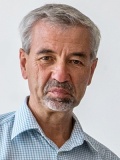
Head of Logistics & Organization Coastal Research
Phone: +49 4152 87 - 2394
E-mail contactHelmholtz-Zentrum Hereon, Institute of Coastal Environmental Chemistry
The project profile of the research platform in Tesperhude as a flyer in pdf format:
Project Profile Research Platform Tesperhude (2,0 MB)

